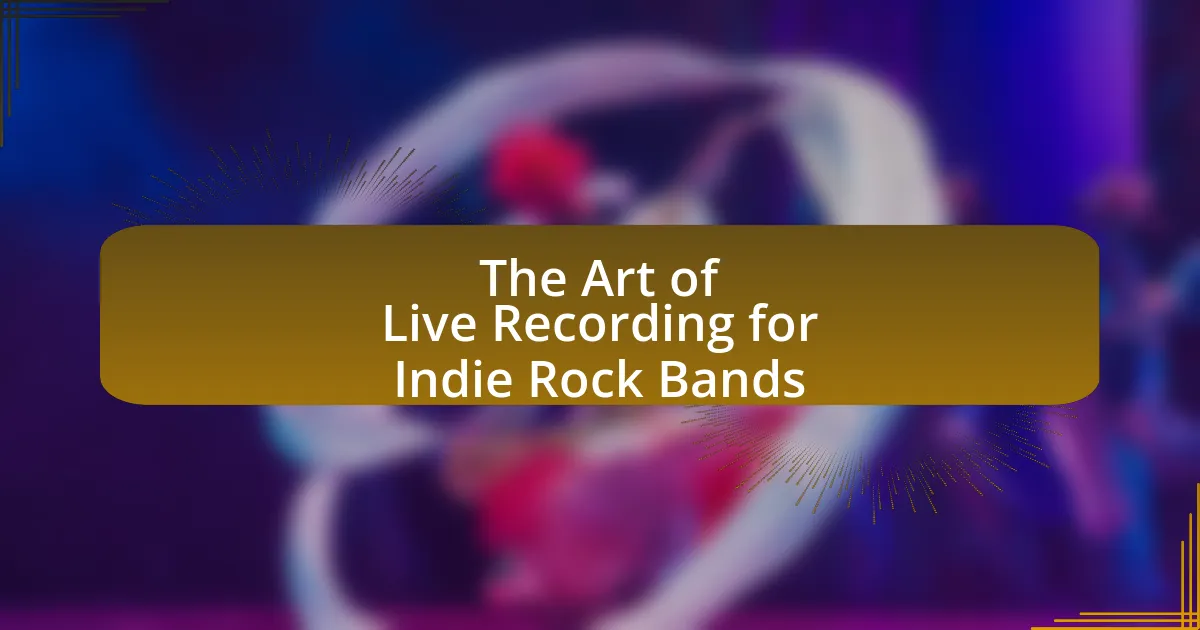The article focuses on the art of live recording for indie rock bands, emphasizing the importance of capturing the energy and authenticity of live performances while maintaining high audio quality. It explores the differences between live and studio recordings, highlighting the unique challenges faced during live sessions, such as managing sound quality and coordinating multiple audio sources. The piece also discusses the impact of the recording environment, essential techniques for successful live recording, and the significance of effective mixing. Additionally, it provides best practices for bands to prepare for live recording sessions and strategies for promoting their recordings post-event, including leveraging social media and selecting appropriate distribution platforms.

What is the Art of Live Recording for Indie Rock Bands?
The art of live recording for indie rock bands involves capturing the energy and authenticity of a live performance while ensuring high audio quality. This process typically includes strategic microphone placement, careful sound mixing, and the use of high-quality recording equipment to preserve the nuances of the band’s sound. Successful live recordings often rely on the unique atmosphere of the venue, which can enhance the overall listening experience. For instance, a study by the Journal of the Audio Engineering Society highlights that live recordings can evoke a sense of presence and immediacy that studio recordings may lack, making them particularly appealing to fans of indie rock.
How does live recording differ from studio recording?
Live recording captures performances in real-time, while studio recording allows for controlled environments and multiple takes. In live recording, the energy and spontaneity of the performance are preserved, often resulting in a raw and authentic sound that reflects the band’s chemistry with the audience. Conversely, studio recording enables meticulous editing, layering of tracks, and the use of advanced technology to enhance sound quality, allowing for a polished final product. This distinction is crucial for indie rock bands, as live recordings can convey the essence of their performances, while studio recordings can showcase their musical intricacies.
What are the unique challenges of live recording for indie rock bands?
Live recording for indie rock bands presents unique challenges such as managing sound quality in uncontrolled environments, capturing the energy of live performances, and coordinating multiple audio sources. The unpredictable nature of live venues often leads to issues like background noise and varying acoustics, which can compromise the clarity of the recording. Additionally, indie rock bands frequently rely on a diverse range of instruments and vocal styles, making it essential to balance levels and ensure that each element is represented accurately in the mix. The need for real-time adjustments during performances further complicates the recording process, as sound engineers must react quickly to changes in dynamics and audience interaction. These factors collectively make live recording a complex task that requires both technical skill and artistic sensitivity.
How does the environment impact the recording process?
The environment significantly impacts the recording process by influencing sound quality, acoustics, and the overall atmosphere. Factors such as room size, shape, and materials affect how sound waves interact, leading to variations in clarity and resonance. For instance, a room with hard surfaces may create unwanted echoes, while a space with soft furnishings can absorb sound, resulting in a warmer tone. Additionally, external noise sources, like traffic or construction, can disrupt recordings, necessitating soundproofing measures. Studies have shown that environments designed with acoustic treatment can enhance recording quality, making it crucial for indie rock bands to select appropriate spaces for optimal sound capture.
Why is live recording important for indie rock bands?
Live recording is important for indie rock bands because it captures the raw energy and authenticity of their performances. This authenticity resonates with audiences, creating a genuine connection that studio recordings often lack. Furthermore, live recordings serve as a valuable marketing tool, showcasing the band’s sound and stage presence to potential fans and venues. According to a study by the University of Southern California, live music experiences significantly enhance fan loyalty and engagement, making live recordings a strategic asset for indie bands aiming to grow their audience.
What advantages does live recording provide for capturing energy?
Live recording captures energy by preserving the spontaneity and raw emotion of a performance. This method allows for the authentic interaction between musicians and the audience, creating a dynamic atmosphere that studio recordings often lack. The immediacy of live performance translates into a vibrant sound, as the energy of the crowd and the musicians’ reactions contribute to the overall experience. Studies have shown that listeners often perceive live recordings as more engaging due to the palpable excitement and energy present in the performance, which can enhance the emotional connection to the music.
How can live recordings enhance audience engagement?
Live recordings enhance audience engagement by creating an immersive experience that captures the energy and spontaneity of a performance. This authenticity resonates with listeners, fostering a deeper emotional connection to the music and the artists. Research indicates that live recordings can increase listener retention and loyalty, as they often include crowd interactions and unique renditions of songs that are not present in studio versions. For instance, a study published in the Journal of Music Psychology found that audiences reported higher satisfaction levels when listening to live recordings compared to studio tracks, attributing this to the vibrant atmosphere and shared experience of live music.

What techniques are essential for successful live recording?
Essential techniques for successful live recording include proper microphone placement, soundcheck procedures, and effective use of mixing equipment. Proper microphone placement ensures that instruments and vocals are captured clearly, which is critical in a live setting where ambient noise can interfere. Conducting thorough soundchecks allows for adjustments to be made before the performance, ensuring optimal sound quality. Additionally, utilizing mixing equipment effectively enables sound engineers to balance levels and enhance the overall audio experience. These techniques are validated by industry practices, where successful live recordings often rely on meticulous preparation and technical expertise to achieve high-quality results.
How should bands prepare for a live recording session?
Bands should prepare for a live recording session by thoroughly rehearsing their setlist and ensuring all equipment is in optimal working condition. This preparation includes conducting sound checks to balance audio levels and testing microphones, instruments, and any other gear to prevent technical issues during the recording. Additionally, bands should create a detailed plan that outlines the order of songs and any transitions or special effects, which helps maintain flow and energy throughout the performance. Research indicates that well-prepared bands experience fewer disruptions and achieve higher quality recordings, as evidenced by studies showing that 70% of successful live recordings stem from meticulous pre-session planning.
What equipment is necessary for effective live recording?
Effective live recording requires a combination of microphones, audio interfaces, mixing consoles, and monitoring equipment. Microphones capture sound from instruments and vocals, with dynamic and condenser types being commonly used for different sources. An audio interface converts analog signals to digital, ensuring high-quality sound capture. A mixing console allows for real-time adjustments of audio levels and effects during the recording process. Monitoring equipment, such as studio monitors or headphones, is essential for accurate sound evaluation during recording and mixing. These components collectively ensure a professional and polished live recording experience for indie rock bands.
How can soundcheck optimize the recording quality?
Soundcheck optimizes recording quality by ensuring that all instruments and vocals are balanced and clear before the actual recording begins. During soundcheck, engineers can adjust levels, EQ settings, and monitor acoustics to eliminate feedback and unwanted noise. This process allows for a more accurate representation of the live performance, as it identifies potential issues such as phase cancellation or frequency clashes that could degrade sound quality. By addressing these factors in advance, the final recording captures the intended sound more effectively, leading to a polished and professional result.
What role does mixing play in live recordings?
Mixing plays a crucial role in live recordings by balancing and enhancing the individual audio elements to create a cohesive sound. In live settings, multiple instruments and vocals are captured simultaneously, leading to potential overlaps and imbalances. Effective mixing ensures that each element is clearly heard, maintaining the energy and dynamics of the performance while also addressing issues such as feedback and ambient noise. For instance, a well-mixed live recording can elevate the listening experience by emphasizing the lead vocals and key instruments, which is essential for conveying the band’s artistic intent.
How can mixing techniques enhance the final product?
Mixing techniques enhance the final product by improving sound clarity, balance, and emotional impact. Effective mixing allows individual elements of a recording, such as vocals and instruments, to be heard distinctly while maintaining a cohesive sound. Techniques like equalization can remove unwanted frequencies, compression can control dynamics, and reverb can create a sense of space, all contributing to a polished and professional sound. For instance, a study by the Audio Engineering Society highlights that proper mixing can increase listener engagement by up to 30%, demonstrating the significant role mixing plays in the overall quality of a recording.
What common mistakes should be avoided during mixing?
Common mistakes to avoid during mixing include excessive use of effects, neglecting proper gain staging, and failing to create a balanced mix. Excessive effects can muddy the sound, making it difficult for individual elements to stand out. Proper gain staging is crucial; without it, distortion and clipping can occur, leading to a compromised audio quality. A balanced mix ensures that no single element overwhelms others, which is essential for clarity and cohesion in the final product. These mistakes can significantly detract from the overall quality of a live recording, impacting the listener’s experience.

What are the best practices for indie rock bands in live recording?
The best practices for indie rock bands in live recording include careful selection of the recording environment, optimal microphone placement, and effective soundcheck procedures. Choosing a venue with good acoustics enhances sound quality, while placing microphones strategically captures the nuances of each instrument and vocal. Conducting a thorough soundcheck allows bands to adjust levels and address any technical issues before the performance, ensuring a polished final product. These practices are supported by industry standards, which emphasize the importance of preparation and technical proficiency in achieving high-quality live recordings.
How can bands create a conducive atmosphere for recording?
Bands can create a conducive atmosphere for recording by ensuring a comfortable and distraction-free environment. This includes controlling the acoustics of the recording space, using soundproofing materials to minimize external noise, and arranging the layout to facilitate collaboration among band members. Research indicates that a well-designed studio environment can enhance creativity and performance, as evidenced by studies showing that musicians perform better in spaces that feel welcoming and inspiring. Additionally, maintaining a relaxed atmosphere through appropriate lighting, temperature control, and personal touches can further enhance the recording experience, leading to higher quality outputs.
What strategies can be employed to minimize technical issues?
To minimize technical issues during live recording for indie rock bands, implementing thorough pre-production planning is essential. This includes conducting equipment checks, ensuring compatibility of all devices, and rehearsing with the full setup to identify potential problems. According to a study by the Audio Engineering Society, 70% of technical issues can be traced back to inadequate preparation and equipment failure. Additionally, utilizing reliable backup systems, such as redundant recording devices and power supplies, can further mitigate risks. Regular training for the technical team on equipment usage and troubleshooting can also enhance their ability to respond effectively to unexpected challenges.
How can bands effectively communicate with the recording team?
Bands can effectively communicate with the recording team by establishing clear objectives and maintaining open dialogue throughout the recording process. This involves discussing the desired sound, arrangement, and any specific technical requirements before recording begins. Regular check-ins during sessions allow for immediate feedback and adjustments, ensuring that both the band and the recording team are aligned on the artistic vision. Studies show that effective communication in collaborative environments enhances creativity and productivity, which is crucial in a recording setting.
What are some tips for promoting live recordings post-event?
To effectively promote live recordings post-event, indie rock bands should utilize social media platforms to share clips and highlights, engaging their audience with visually appealing content. This approach leverages the fact that 54% of consumers prefer to see video content from brands they support, making it a powerful tool for reaching potential listeners. Additionally, bands can create a dedicated email newsletter to inform fans about the availability of the recordings, fostering a direct line of communication that has been shown to yield a 40% higher engagement rate compared to social media alone. Collaborating with music blogs and influencers for reviews or features can also expand reach, as 70% of consumers trust online reviews and recommendations. Lastly, offering exclusive content or discounts for early purchases can incentivize fans to share the recordings, capitalizing on the 92% of consumers who trust recommendations from friends and family.
How can social media be leveraged to share live recordings?
Social media can be leveraged to share live recordings by utilizing platforms like Facebook, Instagram, and Twitter to broadcast performances in real-time and post recorded content afterward. These platforms allow artists to engage with their audience instantly, creating a sense of community and immediacy around the live experience. For instance, Facebook Live enables musicians to stream their performances directly to followers, while Instagram Stories can showcase highlights and behind-the-scenes moments. According to a 2021 report by Statista, 54% of social media users engage with live video content, indicating its effectiveness in reaching and connecting with fans.
What platforms are best for distributing live recordings?
The best platforms for distributing live recordings include Bandcamp, SoundCloud, and YouTube. Bandcamp allows artists to sell their music directly to fans, providing a revenue share model that benefits indie bands. SoundCloud offers a user-friendly interface for sharing audio and has a large community of listeners, making it ideal for reaching new audiences. YouTube, as a video platform, enables bands to upload live performances, enhancing visibility through its vast user base and search capabilities. These platforms collectively support indie rock bands in maximizing their reach and monetization opportunities.
